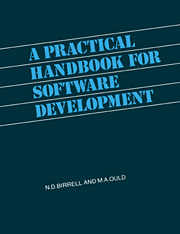Book contents
- Frontmatter
- Contents
- Foreword
- Preface
- 1 The choices facing the system developer
- 2 The software development process
- 3 Development techniques
- 4 Project Inception
- 5 System Definition
- 6 System Design
- 7 System Production
- 8 System Acceptance and Post-Acceptance Development
- 9 Project Debriefing
- Other bibliographies
- References
- Index
9 - Project Debriefing
Published online by Cambridge University Press: 11 January 2010
- Frontmatter
- Contents
- Foreword
- Preface
- 1 The choices facing the system developer
- 2 The software development process
- 3 Development techniques
- 4 Project Inception
- 5 System Definition
- 6 System Design
- 7 System Production
- 8 System Acceptance and Post-Acceptance Development
- 9 Project Debriefing
- Other bibliographies
- References
- Index
Summary
The purpose of Project Debriefing
Now that the development project is over and your system is installed it is time to make sure that future projects will benefit from what you have achieved and learnt. This is the purpose of Project Debriefing; to record your experiences in carrying out the project in a way that will be of benefit to other projects and which will add to your organisation's collective database of project statistics.
The way in which the results of Project Debriefing can most help your organisation is in planning future projects. Such planning may be at the start of a new project or as part of a tendering activity. In either case the collected experiences of previous projects are of inestimable value in producing accurate project plans. For this reason, Project Debriefing should be strongly related to the topics of estimation and indicators discussed in chapter 2.
If you have been recording indicators throughout the project it will require little effort to organise, summarise and record these indicators as part of Project Debriefing. Of special importance will be indicators related to attributes used in arriving at the project plan (those of type (ii) on page 19). These indicator values can be used in updating the calibration of your cost estimation model or in pin-pointing weaknesses in the model. Weaknesses in the model or its use may show up in the form of input parameters to the model whose estimated values consistently bear no resemblance to their final values.
Information
- Type
- Chapter
- Information
- A Practical Handbook for Software Development , pp. 226 - 232Publisher: Cambridge University PressPrint publication year: 1985
